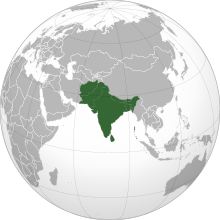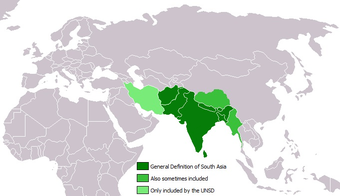တောင်အာရှ
 | |
| ဧရိယာ | ၅,၁၃၄,၆၄၁ km2 (၁,၉၈၂,၄၉၆ sq mi) |
|---|---|
| လူဦးရေ | 1,947,628,100(2020)[၁] |
| လူဦးရေ သိပ်သည်းမှု | ၃၆၂.၃/km2 (၉၃၈/sq mi) |
| GDP (nominal) | $3.326.trillion(2020)[၂] |
| GDP (PPP) | $12.752 trillion (2018)[၃] |
| Demonym | တောင်အာရှသားများ (အင်္ဂလိပ်: South Asian) ဒေစီ(Desi) (အရပ်သုံး) |
| နိုင်ငံများ | |
| အမှီအခိုနယ်မြေများ | |
| ဘာသာစကားများ | ရုံးသုံးဘာသာစကားများ
အခြားဘာသာစကားများ
|
| အချိန်ဇုန်များ | |
| အင်တာနက်ဒိုမိန်း | .af, .bd, .bt, .in, .io, .lk, .mv, .np, .pk |
| အကြီးဆုံးမြို့များ | List
|
တောင်အာရှ (အင်္ဂလိပ်: South Asia or Sourthern Asia) သည် ပထဝီ အနေအထားအရ လည်းကောင်း၊ လူမျိုးစုများနှင့် ယဉ်ကျေးမှုဆိုင်ရာအရ လည်းကောင်း အဓိပ္ပာယ် ဖွင့်ဆိုထားသော အာရှတိုက်၏ တောင်ပိုင်းဒေသ ဖြစ်သည်။ ဤဒေသတွင် အာဖဂန်နစ္စတန်နိုင်ငံ၊ ဘင်္ဂလားဒေ့ရှ်နိုင်ငံ၊ ဘူတန်နိုင်ငံ၊ အိန္ဒိယနိုင်ငံ၊ မော်လဒိုက်နိုင်ငံ၊ နီပေါနိုင်ငံ၊ ပါကစ္စတန်နိုင်ငံ နှင့် သီရိလင်္ကာနိုင်ငံတို့ ပါဝင်သည်။[၄]
တောင်အာရှဒေသ ပူးပေါင်းဆောင်ရွက်ရေးအသင်း (SAARC) သည် ၁၉၈၅ ခုနှစ်တွင် တည်ထောင်ခဲ့သော ဒေသတွင်း စီးပွားရေး ပူးပေါင်းဆောင်ရွက်မှုဆိုင်ရာ အဖွဲ့အစည်းဖြစ်ပြီး၊ တောင်အာရှရှိ ၈-နိုင်ငံစလုံး ပါဝင်သည်။[၅]
အဓိပ္ပာယ် ဖွင့်ဆိုချက်များ
[ပြင်ဆင်ရန်]
တောင်အာရှ၏ ခေတ်သစ် အဓိပ္ပာယ်ဖွင့်ဆိုချက်များအရ အာဖဂန်နစ္စတန်နိုင်ငံ၊ အိန္ဒိယနိုင်ငံ၊ ပါကစ္စတန်နိုင်ငံ၊ ဘင်္ဂလားဒေ့ရှ်နိုင်ငံ၊ သီရိလင်္ကာနိုင်ငံ၊ နီပေါနိုင်ငံ၊ ဘူတန်နိုင်ငံနှင့် မော်လဒိုက်နိုင်ငံတို့ ပါဝင်သည်။[၇][၈][၉] သို့သော် အချို့က အာဖဂန်နစ္စတန်ကို အာရှအလယ်ပိုင်းနိုင်ငံအဖြစ် သော်လည်းကောင်း၊ အနောက်အာရှနိုင်ငံအဖြစ် သော်လည်းကောင်း၊ အရှေ့အလယ်ပိုင်းနိုင်ငံအဖြစ် သော်လည်းကောင်း သတ်မှတ်ပြန်သည်။[၁၀][၁၁][၁၂][၁၃][၁၄] ဒုတိယ အင်္ဂလိပ် - အာဖဂန်စစ်ပွဲအပြီးတွင် အာဖဂန်နစ္စတန်နိုင်ငံသည် ၁၉၁၉ ခုနှစ်အထိ ဗြိတိန်နိုင်ငံ၏ ကာကွယ်စောင့်ရှောက်ခံနိုင်ငံတစ်ခု ဖြစ်ခဲ့သည်။[၁၅][၇][၉] အခြားတစ်ဖက်မှကြည့်လျှင် ၁၈၈၆ မှ ၁၉၃၇ အတွင်း ဗြိတိသျှအင်ပိုင်ယာ၏ အစိတ်အပိုင်းတစ်ခု (British Raj) အဖြစ် အုပ်ချုပ်ခဲ့သော[၁၆]၊ ယခုအခါ အရှေ့တောင်အာရှ၏ အစိတ်အပိုင်းအဖြစ် အာဆီယံအဖွဲ့ဝင်နိုင်ငံတစ်နိုင်ငံအဖြစ် အများအားဖြင့် သတ်မှတ်ထားသည့် မြန်မာနိုင်ငံကိုလည်း တစ်ခါတစ်ရံ တောင်အာရှတွင် ထည့်သွင်းထားခဲ့ဖူးသည်။[၁၀][၁၁][၁၇]
မှတ်စုများ
[ပြင်ဆင်ရန်]- ↑ Among the top 100 urban areas of the world by population.
ကိုးကား
[ပြင်ဆင်ရန်]- ↑ Southern Asia Population, October 2020။ Worldometer။ 26 October 2020 တွင် ပြန်စစ်ပြီး။
- ↑ World Economic Outlook Database (October 2020)။ 10 November 2020 တွင် ပြန်စစ်ပြီး။
- ↑ Report for Selected Countries and Subjects။ IMF။ Outlook Database, October 2018
- ↑ Afghanistan။ Institute of Development Studies။ 20 May 2017 တွင် မူရင်းအား မော်ကွန်းတင်ပြီး။ 28 February 2019 တွင် ပြန်စစ်ပြီး။;
Composition of macro geographical (continental) regions, geographical sub-regions, and selected economic and other groupings: Southern Asia။ 17 April 2010 တွင် မူရင်းအား မော်ကွန်းတင်ပြီး။ 31 January 2016 တွင် ပြန်စစ်ပြီး။;
Arnall, A (24 September 2010). "Adaptive Social Protection: Mapping the Evidence and Policy Context in the Agriculture Sector in South Asia". Institute of Development Studies (345).;
The World Bank။ 10 November 2015 တွင် မူရင်းအား မော်ကွန်းတင်ပြီး။ 5 November 2015 တွင် ပြန်စစ်ပြီး။;
Institute of Development Studies: Afghanistan။ 1 June 2017 တွင် မူရင်းအား မော်ကွန်းတင်ပြီး။ 29 November 2020 တွင် ပြန်စစ်ပြီး။;
Harvard South Asia Institute: "Afghanistan"။ 17 November 2015 တွင် မူရင်းအား မော်ကွန်းတင်ပြီး။ 5 November 2015 တွင် ပြန်စစ်ပြီး။;
"Afghanistan"၊ BBC News၊ 2018-01-31။;
The Brookings Institution (2001-11-30)။ 5 September 2015 တွင် မူရင်းအား မော်ကွန်းတင်ပြီး။ 5 November 2015 တွင် ပြန်စစ်ပြီး။;
South Asia။ The World Factbook။ Central Intelligence Agency။ 2 April 2015 တွင် မူရင်းအား မော်ကွန်းတင်ပြီး။ 29 November 2020 တွင် ပြန်စစ်ပြီး။ - ↑ SAARC Summit။ SAARC။ SAARC Summit။ 16 December 2013 တွင် မူရင်းအား မော်ကွန်းတင်ပြီး။ 17 December 2013 တွင် ပြန်စစ်ပြီး။
- ↑ Standard Country or Area Codes for Statistical Use။ Millenniumindicators.un.org။ 11 July 2017 တွင် မူရင်းအား မော်ကွန်းတင်ပြီး။ 2012-08-25 တွင် ပြန်စစ်ပြီး။ Quote: "The assignment of countries or areas to specific groupings is for statistical convenience and does not imply any assumption regarding political or other affiliation of countries or territories by the United Nations."
- ↑ ၇.၀ ၇.၁ "Afghanistan Country Profile"၊ BBC News။
- ↑ The Brookings Institution (2001-11-30)။ 5 September 2015 တွင် မူရင်းအား မော်ကွန်းတင်ပြီး။ 5 November 2015 တွင် ပြန်စစ်ပြီး။
- ↑ ၉.၀ ၉.၁ CIA "The World Factbook"။ 2 April 2015 တွင် မူရင်းအား မော်ကွန်းတင်ပြီး။ 29 November 2020 တွင် ပြန်စစ်ပြီး။
- ↑ ၁၀.၀ ၁၀.၁ Ghosh၊ Partha Sarathy (1989)။ Cooperation and Conflict in South Asia။ Technical Publications။ pp. 4–5။ ISBN 978-81-85054-68-1။ 16 May 2016 တွင် မူရင်းမှ မော်ကွန်းတင်ပြီး ။ 12 August 2015 တွင် ပြန်စစ်ပြီး။
- ↑ ၁၁.၀ ၁၁.၁ Jona Razzaque (2004)။ Public Interest Environmental Litigation in India, Pakistan, and Bangladesh။ Kluwer Law International။ pp. 3 with footnotes 1 and 2။ ISBN 978-90-411-2214-8။ 7 October 2017 တွင် မူရင်းမှ မော်ကွန်းတင်ပြီး ။ 11 December 2016 တွင် ပြန်စစ်ပြီး။
- ↑ Keith Robbins (2012)။ Transforming the World: Global Political History since World War II။ Palgrave Macmillan။ p. 386။ ISBN 978-1-137-29656-6။, Quote: "Some thought that Afghanistan was part of the Middle East and not South Asian at all".
- ↑ * Saez၊ Lawrence (2012)၊ The South Asian Association for Regional Cooperation (SAARC): An emerging collaboration architecture၊ Routledge၊ p. 58၊ ISBN 978-1-136-67108-1၊
Afghanistan is considered to be part of Central Asia. It regards itself as a link between Central Asia and South Asia.
- ↑ Phillip Margulies (2008)။ Nuclear Nonproliferation။ Infobase Publishing။ p. 63။ ISBN 978-1-4381-0902-2။, Quote: "Afghanistan, which lies to the northwest, is not technically a part of South Asia but is an important neighbor with close links and historical ties to Pakistan."
- ↑ Harvard South Asia Institute: "Afghanistan"။ 17 November 2015 တွင် မူရင်းအား မော်ကွန်းတင်ပြီး။ 5 November 2015 တွင် ပြန်စစ်ပြီး။
- ↑ Baten, Jörg (2016)။ A History of the Global Economy. From 1500 to the Present.။ Cambridge University Press။ p. 287။ ISBN 978-1-107-50718-0။
- ↑ Sushil Mittal and Gene Thursby, Religions of South Asia: An Introduction, page 3, Routledge, 2006, ISBN 9781134593224
